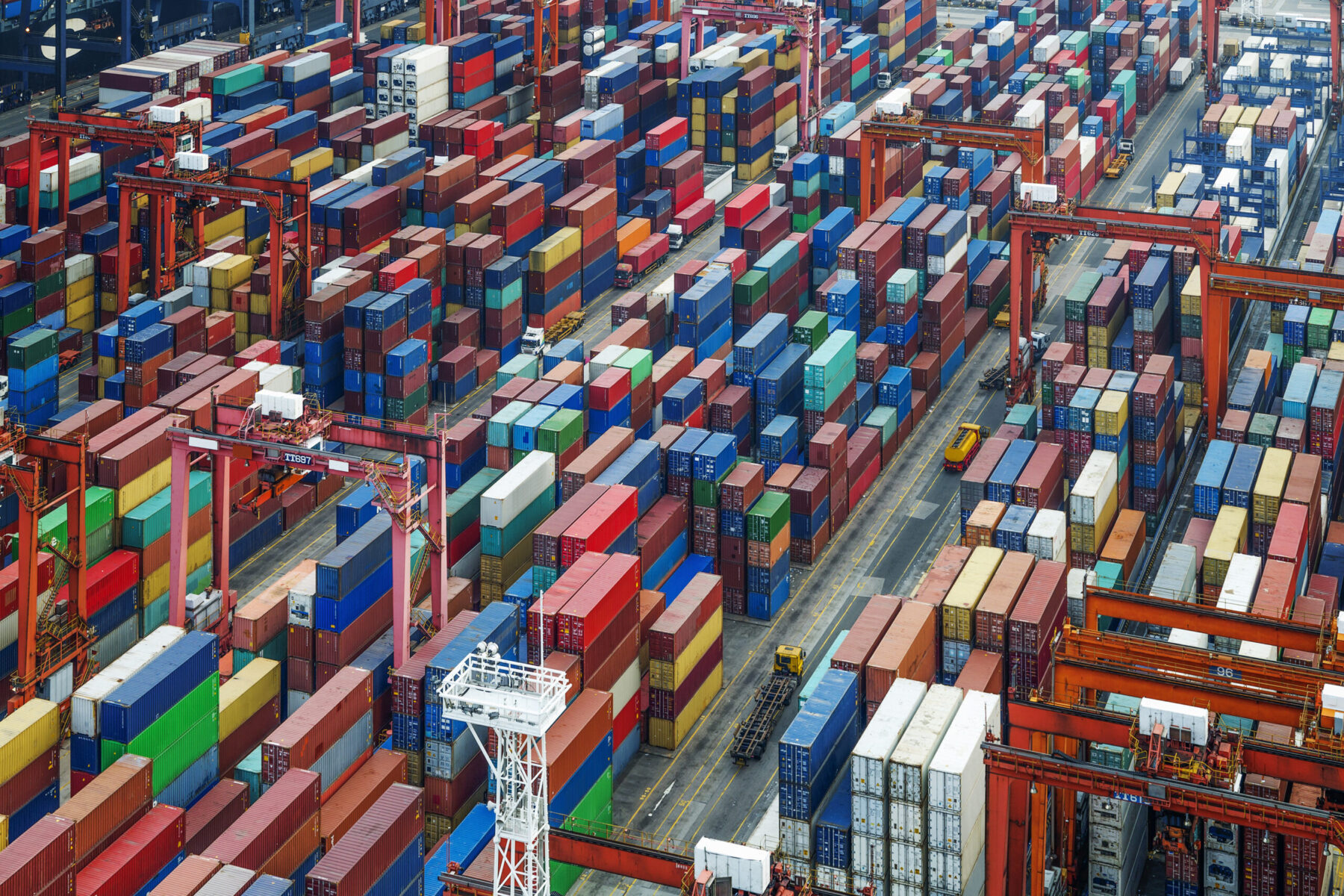How experts at Lenovo and DS Smith tackle supply chain disruption
May 27, 2022
Scroll to find out more
May 27, 2022
Scroll to find out more

Supply chains are famously complex, involving vast volumes of goods moving through huge numbers of manufacturers, suppliers and stakeholders. With unpredictable lead times and soaring costs throwing ever more challenges at supply chain teams, we brought together a team of experts at Navigate Smarter 2022 to discuss how to cut through complexity to get results despite disruption.
Our guests, Harold Hendrickx, Director of Global Enablement and Transformation at DS Smith, Gareth Davies, Head of Global Logistics, Lenovo, came together to share how businesses can stay in control in volatile times.
Supply chain visibility has become a mantra in the industry. But visibility alone is not enough – partly because there’s just so much to see.
Gareth put it into context: ‘In our world, you’ve got visibility into parts availability, goods that may not be on their way to you yet, visibility of potential orders, as well as actual orders. There’s also process and management visibility to qualify issues and potential network disruptions, and even visibility of trends.’
Just seeing what’s going on and where can’t be a goal in itself. It has to lead to something. ‘The core goal here is alignment.’ says Gareth.
‘Your suppliers, your team, your partners all need to have the same understanding of your goals. That means the human element of your network is then synchronised with the systems, which creates a very strong mechanism to identify potential problems and take corrective actions.’
This visibility also needs to be backed up with a structure that helps create clear decision-making based on the information you’re receiving, as Harold explains further:‘You might have different teams looking at different steps of the process or different elements, but you need single ownership and clarity on who takes each decision on driving and setting that standard, because if you don’t, then those elements will not be connected.’
Harold also warns against visibility for its own sake. ‘We often think that the more information the better, but that’s not always the case. Bringing focus on what you need to have also means understanding what you don’t.’
Global supply chain complexity has been growing continuously for the 21st century but many organisations have seen their supply networks expand especially rapidly over the last two years, leading to previously adequate processes becoming inefficient and muddier decision-making.
So where do you start with fixing it? The answer is not always as simple as buying a new technology platform – sometimes, it’s even simpler. For Harold, it starts with clear goals and priorities that can be run through the process and used to benchmark issues and performance.
‘Everything starts with what you want to achieve and your desired outcome. You often see that an intent or desired outcome is not specific enough or it’s too broad. Then you end up bringing in more processes, which are not aligned or adding tools. From my experience, often companies don’t need more technology – they need less, but it has to be smart and fit for purpose.’
It’s not just about equipping people with the right technology. As Gareth suggests, it’s also about freeing them to take action.
‘We’ve succeeded by looking at and empowering who exactly is best placed to make decisions. Often they need to be made fast so you need to choose a source that can help you make that happen. Reduce the complexity and make sure the ownership is clear, then put hierarchy into that process.’
By reducing ambiguity over decision-making, contingencies and changes, this shrinks the window for disruption by making the next step clear, explains Gareth.
‘We prioritise, so that this volume goes to this carrier, then we move it to this other carrier, or this MOT, or it goes to this gateway – so the team executing this can use that matrix and progress orders almost by default. It removes other influences that would make them second guess themselves.’
By clearly setting the source for each information point or decision, Gareth’s team can focus on solving root issues, rather than treating symptoms. Measuring performance on a node-by-node basis, they can solve informational or execution issues at source, rather than by adding more processes or tools.

If visibility is a means to an end, the fixed point around which you then base your decisions is your intent as a team. This is especially important in a world where there may not always be the perfect answer – often your best bet is to choose the best directionally-correct option with the information you have.
Gareth put it in perspective: ‘We’re not working like an equation – we’re in a service industry. There may not always be a right answer – just the best answer given the data that you had at a moment in time, the priorities and parameters you were up against and the time that you had to make that decision. And it might be different from the one you would’ve made yesterday.’
In a world of competing priorities, a clear sense of purpose and mission is essential to connect the dots and your stakeholders.
Harold says, ‘You need to have a common objective that everybody understands. If you have that intent or the purpose set in your company then all the way through line management, people can judge whether the decision that they’re making today will be in line with what we are trying to achieve as a company, or as a function, or, or as a team.’
Then your next step is to have the insights and information to make decisions that contribute to that intent.’
While it’s straightforward enough to set a vision, diffusing it through layers of stakeholders, especially external ones, presents a significant challenge. There’s only so far top-down mandates will get you. In this scenario, Gareth suggests a different approach: look to the middle.
‘There are always top-down decisions, but I think there’s a layer of mid-management that has the opportunity and the obligation, perhaps, to simplify this. They know better than I ever will what’s working and what’s not. So we’ve stripped out everything from top down to just be, ‘What is the objective, what are we trying to achieve?’ then we let the answers flow from the bottom up.’
‘It means listening to team members – you’re empowering them to come up with suggestions and make changes. They can take the top-down directives and strip out some of the steps or the requirements as long as they’re adhering to the core fundamentals that have to be achieved.’
This leads to the counterintuitive idea that getting your supply chain under control means loosening your grip. The top-down tactics that worked in solid-state planning scenarios just don’t work in a world in flux: all of which requires a new style of leadership.
Harold is an advocate for having boundaries. ‘Top leadership needs to limit themselves to setting the direction and leave it at that. And that’s hard – you need to make sure you have an adaptive, situational, motivational, inspirational leadership style to unlock the potential of middle management to come up with the proper solutions.’
‘The lesson I see is daring to delegate and ask for help. You go into a supportive role that is, honestly, hard for senior leaders. People think strong leadership is about telling people what to do but I think it’s the opposite – and that’s after 20 years of military experience. The first thing that you learn in the academy is that you don’t know anything; you need to listen to your people.’
The clear lesson of recent years, and of this panel, is that complexity is not going anywhere, and simply adding more processes, platforms and people without a plan isn’t a solution. In dynamic times, the most important thing we can do is to be dynamic too.
As Gareth puts it, ‘Refocus your focus and do this all the time. You’ve got a finite amount of time. You’ve got a finite amount of energy and you need to apply that to the things you can influence.’
‘Decide daily, what are the absolute fundamentals that I need to do – that’s how you make sure you’re aligned with your stakeholders, your customers, your management team and your peer group. Whether it’s cost, segment, country, volume: choose your key priorities, communicate them and align your actions.’
Reducing complexity today is about more than visibility. It’s about having the purpose, structure and insight to react to a changing market with data-driven decisions.
Zencargo’s supply chain management platform is built with agility in mind. With structured roles, data and permissions, it’s a way to empower your team with clear processes, timely information and the tools to measure the impact of your actions.
To find out more about how we help some of the world’s leading businesses find the signal in the supply chain noise, book a call with one of our supply chain experts.

To find out how you can take control of your supply chain costs and stay ahead...

To find out how you can navigate a path through uncertainty, book your free str...

To find out more about how Zencargo’s digital freight forwarding experts and te...